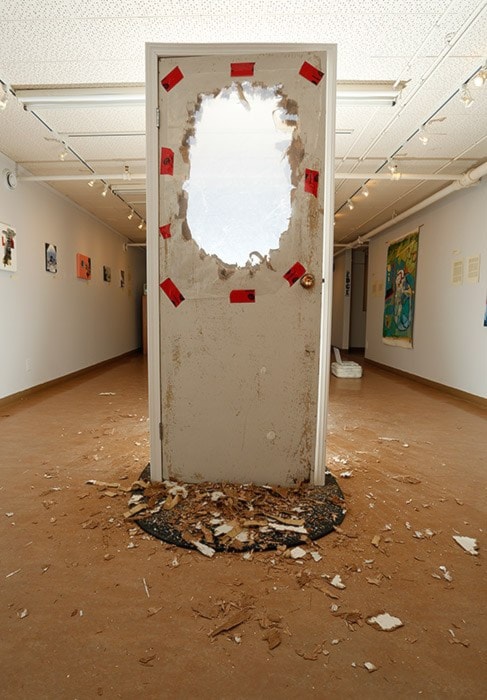Charles Stankievech’s masterpiece resembles a military station on an acid trip.
It’s a 10-foot-tall soccer ball-like dome with lights that psychedelically flash the colours of the rainbow.
But it’s more meaningful than it sounds. And it’s brought the Dawson-based artist all the way to Germany.
The DEW Project is an homage to the Distant Early Warning line that was to detect Soviet missiles and bombers during the Cold War.
“The value of these warning systems is obvious,” reported The Lewiston Daily Sun in November, 1954.
That was three years before the line was declared fully operational.
“Before the enemy could reach the Mid-Canada line, which will be manned with audio-visual devices as well, US and Canadian fighters would be in the air searching for the foe.”
That was also published 24 years before the artist was born.
Yet he was still inspired by the warning system that was built way before his time.
“I think the DEW project is a strong symbol internationally of what people think of the Arctic,” said the 32-year-old contemporary artist on the phone from Berlin. “Very few people go to the Arctic, but yet the Canadian identity looms very large as a presence in who we think we are as a country. So as a result we have certain symbols or fantasies of what is in the Arctic - everything from igloos to seal-hunting to Santa Claus to these amazing vistas of the tundra.”
The Cold War and the fear of bombs did play a part in his childhood.
He connects his experience of living in the territory to the memory of bomb drills and sirens.
“When I’m up in the Yukon, there’s this amazing historical infrastructure of the Distant Early Warning system that really I think plays a significant role. It was a symbol for our culture that we grew up in the Cold War and what it meant.”
Remains of the line are still found near Tuktoyaktuk.
Every winter, Stankievech travels the Tuktoyaktuk ice road to see one of the original DEW line stations that hasn’t been updated to be part of the North Warning System.
“So you still see the same infrastructure of the geodesic domes, the antennas and the outpost. So maybe it was built before my birth, it’s still something that is very prevalent.”
His project looks similar to the station that remains intact in the Far North, the exception being the disco-like lights that his flash.
“These things look like outer space stations and I think that that esthetic stays true in my work.”
But his version features a more sci-fi look. That came from the Star Wars influence.
The Empire Strikes Back, one of Stankievech’s favourite films, opens with a battle scene on an Arctic planet.
The real-life stations are also much bigger in size. Their scale is “epic,” said the artist.
“Mine is a little more, shall we say, poetic with its colour.”
The military station sends out a radar signal that bounces back. Stankievech’s sends out hallucinatory lights.
The 1973 book Gravity’s Rainbow, by Thomas Pynchon, also influenced Stankievech’s work. It’s a “very psychedelic, classic American novel” about the V-2 rockets, said Stankievech.
In the first exhibit featuring The DEW Project, Stankievech did a live concert that mixed his ‘60s minimalist music with noise from the Yukon River.
The flow of the water didn’t sound different than it would from any other river, he said. But the ice breaking, once spring came, sounded like a distant thunderstorm. He fused that with the non-melodic sounds of his ‘60s-inspired tracks.
He called this performance Gravity’s Rainbow.
In other exhibits, he plays the sounds of the river that he edited down to 12 minutes from a month’s worth of time.
“Feeling music is really important to my work - the material and visceral reaction to it.”
The music is played quite loud, but sometimes he has to negotiate the volume with the people he’s working with, he said.
The piece and accompanying sound have travelled to the ODD Gallery in Dawson, the Ellen Gallery in Montreal and the Deep Wireless Festival in Toronto. Next week, it will be showcased at the International Symposium on Electronic Art in Dortmund, Germany.
The funding for the project came from the Canada Council for the Arts, but the $16,000 wasn’t nearly enough to cover the costs of building the piece. He had to invest a lot of his own money.
“That’s why I’m a professor,” he joked.
Stankievech taught at Concordia University in Montreal after he received his Master’s in Fine Arts with open media. Three years ago, he moved to Dawson to become one of the first faculty members of the Klondike Institute of Art and Culture.
About $6,000 from the territory’s Touring Artist Fund helped Stankievech travel to Germany to display the piece, to a lecture and exhibit in Toronto, to a lecture in Finland, a performance in Helsinki and a concert in Portugal.
He splits his time between Dawson and Montreal, where he is represented by Galerie Donald Browne.
For now, he’s in Germany setting up the piece, which will begin its showcase August 19.
“This isn’t just a story of me coming to Europe and showing my artwork,” said Stankievech. “While it’s really great that I’m here and able to show this work, it’s also really neat because in this case, the work is about the Yukon. So it’s not just going to be me at the centre of the festival ... as we look at this work, what’s going to be on the forefront is what is its infrastructure and what is this artwork about and what is the story behind this? And the story behind this is the history of the Yukon and the future of the Yukon, both in its past militarization of sovereignty and in the future of its environmental concerns and who owns what land.”
Contact Larissa Robyn Johnston at larissaj@yukon-news.com
